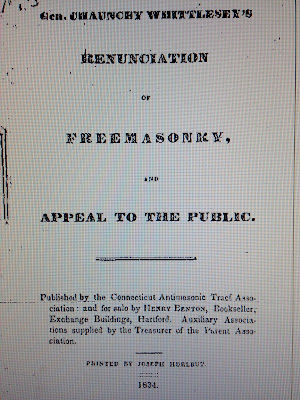This edition of The Magpie Mind admittedly is a mess, but here are announcements of some great local events, so be sure to scroll all the way through.
Last weekend, I had the chance to enjoy some time in my alma mater’s main research library and, instead of doing something useful, I poked through a tiny bit of the thousands of unusual texts pertaining to Freemasonry. Here are just a few images:
- Tomorrow night, The American Lodge of Research will meet to hear Worshipful Master Michael Chaplin present his paper “Patron Saints of the Operatives.” Eight o’clock in the Colonial Room on 10 at Masonic Hall (71 West 23rd Street in Manhattan).
- Monday, November 9 is the deadline for booking your seat at the Scottish Rite Valley of Central Jersey’s Rose Croix celebration featuring Billy Koon:
 |
| Click to enlarge. |
- Next Wednesday, Bro. Mohamad will speak at Livingston Masonic Lodge in New Jersey:
 |
| Click to enlarge. |
- Congratulations to the new officers of the Masonic Library and Museum Association: President Aimee Newell, Vice President Brian Rountree, Secretary Cathy Giaimo, and, returning for another term, Treasurer Eric Trosdahl.
- The MLMA’s 2016 annual meeting is planned tentatively for October at the Lee Lockwood Scottish Rite Library and Museum in Waco, Texas.
- Speaking of Masonic libraries, the Grand Lodge of Nebraska dedicated its library and museum last month at the grand lodge headquarters in Lincoln.
- On Sunday, November 8, Cincinnati Masonic Lodge No. 3 in Morristown, New Jersey (39 Maple Avenue) will unveil the Morristown Masonic Center Museum and Library with an opening reception. Dignitaries to include the chairman of the New Jersey Historical Commission, the chairman of the Morristown Historic Preservation Commission, and RW Bro. Glenn Visscher of the Museum of Masonic Culture in Trenton (and a Past Master of the lodge).
- Looking around the interwebs, I recently found the finest source of Masonic news: The Past Bastard. Click here and be amazed!
- Madison Masonic Lodge No. 93 in New Jersey has undertaken the project of replacing the headstone of Jepthah B. Munn, who was Grand Master of Masons for the State of New Jersey in the 1820s. Donations are welcome here.
I shot these photos Monday in the Presbyterian cemetery across the street from the lodge and, as you can see, this stone has seen better times.
Munn deserves the overdue attention. He was grand master during the age when grand masters were graaaand! A quick history:
In 1837, the Grand Lodge of New York expelled a number of Masons and closed a few lodges that were at labor in New York City. (I haven’t yet learned why they were expelled.) These brethren regrouped and called themselves St. John’s Grand Lodge. At that time, the Grand Lodge of New Jersey adopted a resolution voicing its support of New York’s authority to expel these Masons. This resolution was passed to make it clear from the start that all New Jersey lodges were prohibited from having communication with this clandestine grand lodge.
However, St. John’s Lodge No. 2 in Newark (it became No. 1 later) ignored the prohibition and other, less formal, requests from individual grand officers, and had Masonic intercourse with these New York guys, hosting them in their lodge, etc. For their role in this, Jepthah Munn and John Darcy, both past grand masters, were punished by Grand Lodge of New Jersey for defying grand lodge’s order to not interact with those expelled Masons.
During all of this, some New York lodges, in retaliation for the New Jersey past grand masters’ meddling in this episode, refused to allow New Jersey Masons to visit their lodges. This feuding continued for a number of years, even into the 1850s. What has to be remembered during all of this is that this period is the tail end of the anti-Masonic era that came in the wake of the “Morgan scandal” that nearly saw the fraternity in New York and New Jersey wiped out. For example, in 1842 New Jersey Freemasonry consisted of 162 Masons in eight lodges. So this bickering is kind of like rearranging the deck chairs on the Titanic.
Also, this episode is not all that unusual in the 19th century history of New York Masonry. In the early years of the 1800s, a split between the “country lodges” and the “city lodges” took place that really caused problems. Two very real grand lodges coexisted until 1827, when they united.
Anyway, the clandestine grand lodge Munn aided is not unknown to New York scholars (there actually is a New York lodge named after Munn). He was an interesting man: Born in East Orange in 1780, where there is a Munn Avenue; a renowned medical doctor, who served as president of the Medical Society of New Jersey in 1828, and a co-founder and eventual president of the Morris District Medical Society; a respected member of the New Jersey General Assembly.
He was made a Mason in 1804 in Paterson Orange Lodge 13; affiliated with Cincinnati No. 3 in Morristown, serving as Master from 1809 to 1814; was warrant master of Chatham Lodge 33 (now Madison 93) from 1814 to 1819; and affiliated with St. John’s No. 1 in 1850. Was elected Senior Grand Warden of Grand Lodge in 1817, and served as Grand Master from 1820 to 1824.
Because of his activity in the New York episode, Munn—and this is why I’ve been crazy about him from the minute I learned of him about seven years ago—was subjected to charges of unmasonic conduct in 1842. Charges dropped the next year. Censure was imposed by Grand Lodge in 1850, but withdrawn in 1852. He continued to attend grand lodge communications through 1860, until ill health slowed him down. He died in 1863 in Chatham.


































































































